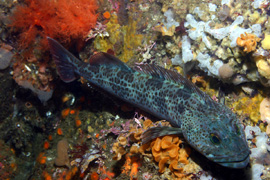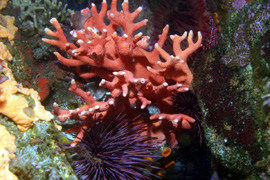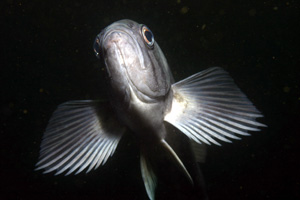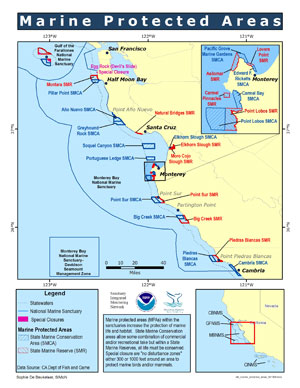Marine Protected Areas
Marine reserves, often referred to as no-take marine protected areas (MPAs), are defined as areas within which human activities that can result in the removal or alteration of biotic and abiotic components of an ecosystem are prohibited or greatly restricted (NRC 2001). Activities typically curtailed within a marine reserve are:
- Extraction of organisms (e.g., commercial and recreational fishing, kelp harvesting, commercial collecting)
- Mariculture
- Activities that can alter oceanographic or geologic attributes of the habitat (e.g., mining, shore-based industrial-related intake, discharges of seawater, effluent)
Usually, marine reserves are established to conserve biodiversity or enhance nearby fishery resources. Thus, goals and objectives of marine reserves can be inferred, even if they are not specifically articulated at the time of reserve formation.
Central California Reserves
On September 21, 2007, after one of the most intensive public processes in ocean governance, 29 new MPAs (204 square miles) went into effect on the Central California Coast; including 9 no-take State Marine Reserves within the Monterey Bay National Marine Sanctuary. Prior to 2007, only three no-take marine reserves existed in the MBNMS: Hopkins Marine Life Refuge, Point Lobos Ecological Reserve, and Big Creek Ecological Reserve. In 2007, all 3 reserves were expanded and renamed; and 6 additional no-take reserves were established within the MBNMS. Understanding the role the new MPAs will play in protecting the ecosystem is a high priority for the Sanctuary.
In 2004 Starr and others reviewed the effectiveness of four California marine reserves, including three marine reserves in the Monterey Bay National Marine Sanctuary: Hopkins Marine Life Refuge, Point Lobos Ecological Reserve, and Big Creek Ecological Reserve (see below for a link to the report).
Efforts to objectively evaluate the reserves in central California, relative to reserve theory, were greatly hampered for four primary reasons:
- Few of the existing marine reserves were created with clearly articulated goals or objectives.
- Relatively few studies of the ecological consequences of existing reserves have been conducted.
- No study to date encompasses the spatial and temporal scope necessary to identify ecosystem-wide effects of reserve protection.
- There are almost no studies that describe the social and economic consequences of existing reserves.

The exceedingly small size of the three marine reserves in central California prevented them from achieving many of the goals and benefits attributed to marine reserves in the scientific literature. The number of fishes and invertebrates inhabiting the reserves was small, compared to the total population sizes of species in central California. Reserves and MPAs in central California protected a variety of shallow water habitats and species, but they did not provide reserve benefits for animals living in deeper water, unless they resided in a reserve during some portion of their lives.

The older marine reserves in central California showed some of the primary benefits associated with protection from exploitation, including modest increases in size and abundance of fishes, but it was difficult to assess the degree to which these benefits represented optimal conditions. This was to be expected, as the primary fish species inhabiting the reserves (rockfishes) are slow growing and exhibit sporadic recruitment. Also, new scientific theories suggest that substantially altered habitats may or may not return to pre-existing states after the disturbance has been removed.
Marine reserves in other temperate and tropical oceans and theoretical models of marine reserves show substantial conservation and some potential fishery benefits. For these reasons, we expect that marine reserves created in central California for conservation purposes would accrue many of the benefits predicted by reserve theory. The extent to which these would successfully benefit fisheries, however, would depend on a large number of social and biological factors, such as social acceptance of reserves, fishery effort shifts, catch regulations, enforcement levels, the proportion of a stock protected in a reserve, rates of movement and larval production of protected species, and reserve size and location.
 Resource Protection and Public Participation
Resource Protection and Public Participation
Effective natural resource management requires public participation and buy-in to management goals, objectives, and regulations. Thus, just as it is vital to evaluate marine reserves for their ecological effectiveness, it is also critical that they be evaluated for their socio-economic values. In this respect, the use of marine reserves is a public policy decision that must be made with consideration of human activities.
For marine reserves to be an effective public policy tool in central California, human use patterns, perceptions, attitudes, and beliefs must be incorporated into the design process. Information about social and economic costs and benefits should also be incorporated to maximize the effectiveness of a reserve system. Ultimately, an understanding of how people interact with the biophysical environment is integral to the design and development of marine reserve goals and objectives.
Excerpts from a report submitted to the MBNMS:
Starr, R.M., M.H. Carr, J. Caselle, J.A. Estes, C. Pomeroy, C. Syms, D.A. VenTresca, and M.M. Yoklavich. 2004. A Review of the Ecological Effectiveness of Subtidal Marine Reserves in Central California. Part I: Synopsis of Scientific Investigations. Marine Sanctuaries Conservation Series MSD-04-02. U.S. Department of Commerce, National Oceanic and Atmospheric Administration, Marine Sanctuaries Division, Silver Spring, MD. 128 pp.
Download the entire report:http://montereybay.noaa.gov/research/techreports/trstarr2004.html
